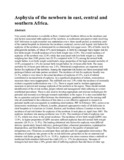| dc.description.abstract | Very scanty information is available in East, Central and Southern Africa on the incidence and risk factors associated with asphyxia of the newborn. A multicentre prospective study involving 4267 deliveries in eight countries was undertaken over a three month period, in maternity units of the central hospitals to determine the incidence; maternal, service and logistic risk factors for asphyxia of the newborn as determined by an abnormally low apgar score. 30% of births were by primigravida mothers, of whom 67% were teenagers. A birth by a teenager had a higher risk for low birth weight. Overall incidence of low birth weight was 13.9%. The overall incidence of asphyxia of the newborn was 22.9% while that associated with low birth weight (i.e. babies weighing less than 2500 grams) was 29.3% compared with 21.5% among the normal birth weight babies. Low birth weight contributed a large proportion of the high neonatal mortality of 15.9% compared to 1.8% for normal birth weight babies by 24 hours after birth. The mean mortality by 24 hours post delivery was 3.8%. Obstetrical complications are important risk factors for asphyxia of the newborn. Among the important risk factors are those associated with prolonged labour and intra partum accidents. The incidence of risk for asphyxia broadly was 21.3%, which is very close to the actual incidence of asphyxia of 22%. Lack of referral contributed to increased risk of asphyxia. In a significant proportion of infants, resuscitation measures taken were inappropriate. The stillbirth rate was 3.0% while the incidence of externally evident congenital malformations was 1.2%. There is urgent need to institute appropriate measures to prevent and manage asphyxia of the newborn in the region. These should include identification of the at risk mother, proper referral and management while adhering to correct established procedures. There is also need to develop appropriate and relevant technologies for perinatal and neonatal care through research undertaken in the region. It is also concluded that the co-operation and joint effort between the obstetricians, paediatricians and the nursing staff who all contributed to the collection of this data is a cost effective approach to research in perinatal health and consequently in instituting interventions.
PIP:
In February 1991, nurses at an intercountry workshops in Maseru, Lesotho, proposed a prospective study of all deliveries in chief hospitals in 8 countries in Central, Eastern, and Southern African Countries to learn the incidence of and risk factors for asphyxia of the newborn. It took place in April-June 1991. The asphyxia incidence rate among newborns was 22.6%. The incidence of risk of asphyxia was 21.3%, which was close to the actual incidence. The incidence of low birth weight (LBW) was 13.9%. A higher proportion of LBW neonates suffered asphyxia than did normal birth weight neonates (29.3% vs. 21.5%). The leading obstetrical risk factors for asphyxia were difficult delivery (particularly breech delivery), prolonged labor, abnormal presentation, cephalopelvic disproportion, and fetal distress. These factors are linked to the quality of prenatal and intrapartum care. Clinicians an anticipate them and plan early for appropriate intervention. The incidence of asphyxia was greater in the at-risk deliveries group than in the no maternal and obstetric risk factor group (34.2% vs. 18.9%). Asphyxia was more common when a midwife or traditional birth attendant delivered the child (33% vs. 17% for physicians). Neonates of teenagers had more than a 50% greater risk of suffering asphyxia than did those of other age groups. They also were more likely to be LBW infants. LBW infants born to teenagers had a higher risk of a low apgar score. LBW infants had a higher 24-hour mortality rate than normal weight infants (15.9% vs. 1.8%). Lack of referral increased the risk of asphyxia. 75% of neonates who died within 24 hours had a low apgar score. The stillbirth rate stood at 3%. This study showed that appropriate measures (e.g., proper referral and management, identification of the at-risk mother) be implemented to prevent and manage newborn asphyxia. Operational research is needed to develop appropriate and relevant technologies for perinatal and neonatal care. | en |

